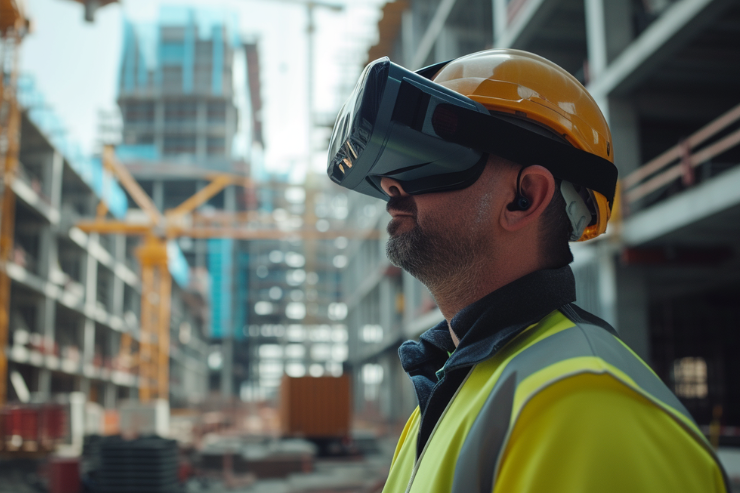
Welcome to a game-changing revolution in construction. Construction is embracing a transformation in a world where technology is shaping various industries.
Today, we explore Virtual Construction and Building Information Modeling (BIM) – technologies reshaping how we build.
It’s not just about bricks and mortar; it’s a new era of precision and efficiency.
Join us as we dive into how these innovative tools change construction practices.
What is Virtual Construction?
Virtual Construction, also known as Virtual Design and Construction (VDC), marks a revolutionary approach to the traditional construction process.
It involves creating a digital replica of a building or infrastructure project before any physical work begins.
This digital twin is not just a static 3D model; it’s a dynamic representation that incorporates various dimensions, including time and cost.
Adopting Virtual Construction, or Virtual Design and Construction (VDC), comes with many benefits that significantly impact various aspects of the construction process.
Here are some of the top benefits:
Virtual Construction provides a three-dimensional digital model that allows stakeholders to visualize the project comprehensively.
This improves visualization and aids in better understanding and decision-making throughout the construction lifecycle.
The collaborative nature of Virtual Construction fosters improved communication among project stakeholders.
Shared access to the digital model promotes collaboration, reducing the likelihood of misunderstandings and refining overall project coordination.
Stakeholders can access a comprehensive digital model with spatial, temporal, and cost dimensions.
This wealth of information supports better decision-making throughout the construction process, from design to execution.
The integration of time as the fourth dimension (4D) enables the creation of a visual timeline for the construction process.
This feature facilitates efficient planning, scheduling, and sequencing, contributing to optimized project management.
Including cost as the fifth dimension (5D) allows for integrating cost data into the digital model.
This results in more accurate budgeting, cost estimation, and resource allocation, helping to optimize the financial aspects of the project.
Virtual Construction optimizes project execution by proactively identifying and resolving potential issues during the digital planning phase, significantly minimizing risks and uncertainties.
This approach, combined with the capability for in-depth analysis and simulation provided by the digital model, also refines quality control.
Stakeholders can maintain high construction standards by preemptively addressing any potential concerns, ensuring smoother and more efficient project outcomes.
The 4D timeline aids in efficient planning and contributes to time optimization.
By visualizing the construction sequence, stakeholders can identify potential bottlenecks and optimize the construction schedule for timely project completion.
Virtual Construction platforms provide a centralized hub for project information. This improves communication by ensuring all stakeholders have access to the most up-to-date data, reducing the chances of miscommunication or conflicting information.
Within Virtual Construction, refined communication is crucial, and MobiClocks®️ plays a significant role in refining communication channels, especially for remote crews.
The platform’s features extend beyond traditional communication, incorporating real-time punches and anomaly detection to ensure seamless operations and immediate issue resolution.
With accurate project timelines and cost information, Virtual Construction enables optimized resource allocation.
This includes manpower, materials, and equipment, ensuring that resources are allocated efficiently to meet project requirements.
Building Information Modeling (BIM) and Virtual Construction are closely related concepts. BIM often serves as a foundational element within the broader framework of Virtual Construction.
Here’s how BIM and Virtual Construction are interconnected:
MobiClocks®️ stands out for its seamless integration with the BIM model, refining project completion in various ways.
MobiClocks®️’ Swift Role Assignments and Real-time Monitoring
In essence, MobiClocks®️’ integration with BIM’s temporal dimension creates a dynamic synergy that optimizes scheduling, improves coordination, and ultimately contributes to the successful and efficient completion of construction projects.
The BIM process serves as the information-rich backbone that fuels Virtual Construction.
The detailed and multidimensional data within BIM models effortlessly integrates with Virtual Construction methodologies, improving visualization, collaboration, and decision-making throughout the construction project lifecycle.
In the world of Virtual Construction, using innovative tools like Building Information Modeling (BIM) and MobiClocks®️ makes building stuff way better.
BIM helps construction professionals plan things in 4D, like a cool digital blueprint with time included. MobiClocks®️ is like a buddy that helps everyone communicate better and makes BIM implementation more productive.
Together, these technologies revolutionize how projects are visualized and executed. They pave the way for a more advanced, connected, and successful future in the construction industry.

There are a lot of ways to deal with no call, no show employees. The policies you enforce will depend on the type of manager you are.

Naturally, productivity and work ethics are positively and strongly correlated. There are many ways to set up a work environment where ethics are valued, and one of the most effective ways has proven to be guidance and empowerment. If you are ready to tak

Having an employee handbook is essential to the efficient operations of your business. In general, it contains all the procedures and policies that go on in your firm. It’s vital to have one, especially in construction companies, where logistics plays a h